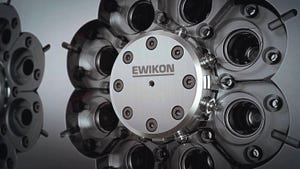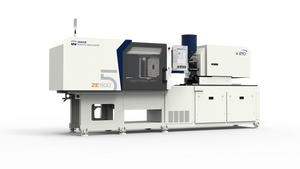July 13, 1999
Editor's note: Estimating shrinkage remains one of the biggest mysteries in the molding industry. The shrinkage rate determines how tools will be cut and how the part will be processed, yet data sheet information, by its very nature, cannot tell the whole story. Three researchers from Dow Chemical derived some concrete shrinkage results from experiments with polypropylene, and share them in this excerpted paper, winner of the Best Injection Molding Paper at Antec '99, presented by IMM and SPE's Injection Molding Division. The authors-Patrick Gipson, Peter Grelle, and Brent Salamon-selected PP for its high shrinkage rate and growing popularity among automotive and durable goods designers. |
Finding out how much a specific part will shrink is not a straightforward matter. In order to cut molds to the correct dimensions, the expected so-called shrinkage number must be known. However, resin suppliers cannot provide a number for a specific polymer grade that will be accurate for different thicknesses of parts and different molding conditions. The shrinkage rate published on a data sheet applies only to the specific molding conditions and thickness of test plaques.
We can start, however, with several given facts. Semicrystalline materials generally have higher shrinkage rates because polymer chains can arrange themselves into crystalline regions where the chains are more densely packed than in amorphous materials. We know that the degree of crystallinity is affected not only by the chemical structure, but also by the rate of cooling during processing. It's logical to assume that cooling variables such as mold temperature, melt temperature, and part thickness play a major role in determining final part dimensions.
When it comes to polypropylene, determining shrinkage can be complicated by the material's high shrinkage characteristics. For this reason, the molding conditions used to fabricate PP parts are critical. To determine some meaningful relationships, experiments using the following eight PP grades were conducted:
RG-1: reactor grade, nonnucleated, 35 MFR (melt flow rate).
RG-2: reactor grade, nucleated, 35 MFR.
RG-3: reactor grade, nonnucleated, 20 MFR.
CP-1 to CP-5: compounded grades containing varying amounts of reactor grade materials, HDPE, talc, and elastomers. MFRs range from eight to 14.
For each of these materials, we studied the effects of variables such as part thickness, hold pressure, mold temperature, melt temperature, injection speed, and flow length.
|
Figure 1. Small mold: shrinkage vs. part thickness. |
Experimental Setup
Two types of plaque molds were used for these experiments-a small mold measuring 6.67 by 6.67 cm (2 5/8 by 2 5/8 inches) and a large mold of 10.1 by 30.5 cm (4 by 12 inches).
Small plaques were molded on a 15-metric-ton Arburg that had a 25-mm screw diameter, and a shot size of 1.1 oz. Part thickness was varied by using different shims behind the scribed insert. The oil-cooled mold contained a full width fan gate, producing one-dimensional flow down the part length.
For the large plaque, a 300-metric-ton Demag machine was used with a 60-mm screw and a 20-oz shot size. The mold cavity, textured on one side, was 2.5 mm thick. This water-cooled mold had a 1-inch center fan gate at one end for one-dimensional flow except at the gate end.
Based on common industry ranges, molding variables were tested at several levels outlined in Table 1. Only one variable was changed at a time; the others were kept at their baseline condition.
Throughout the trials, three factors were held constant: maximum injection pressure, hold time, and cool time. Hold time was set to the maximum needed for gate freeze in all of the experiments. For the small plaque, parameters were 16.5 MPa injection pressure, 17 seconds hold time, and 17 seconds cool time. For the large plaque, settings were 12.4 MPa, 20 seconds for hold time, and 17 seconds for cooling. In addition to these single-variable experiments, two other conditions were evaluated: maximum and minimum shrinkage.
|
Figure 2. Large mold: shrinkage vs. pressure. |
A data acquisition system monitored cavity pressures, injection pressure, and screw position. Part shrinkage measurements were taken with a three-
Studies showed that no significant shrinkage occurred after two days, so plaques were measured one week after molding. During that time, they waxis coordinate measuring machine equipped with an optical video probe for magnifications up to 250x. Error margins using this equipment were ±.0002 cm/cm. To reduce the error, four plaques were molded for each condition, and the average shrinkage measurements were taken.ere stored in a room-temperature-controlled lab. To measure the shrinkage between any two points, the distance on the mold was measured at room temperature. Then the distance between the same two points on the molded part was subtracted from this mold value. The resulting number was divided by the mold value to give shrinkage in cm/cm.
Getting Results
Each of the eight materials showed similar relationships to the chosen injection molding variables. The main difference in results was the magnitude of shrinkage values. Compounded materials, for example, shrank at a level approximately 50 percent lower than that of reactor grade materials. Specifically, shrinkage for reactor grade materials ranged from .013 to .022 cm/cm, while compounded materials ranged from .005 to .010 cm/cm. We also observed that as elastomer content rose, shrinkage decreased.
|
Figure 3. Large mold: shrinkage vs. melt temperature. |
When interpreting the experimental results, it's important to remember that the baseline condition for each material is the result of the same machine settings, not necessarily equivalent cavity conditions. Cavity pressure was monitored as a response variable and used to correlate with shrinkage results. But it was not used to set molding conditions.
Results of both large and small mold experiments showed that shrinkage decreases with increasing cavity pressure. The relationship remained the same, regardless of mold size: shrinkage = (-1 x 10-6 x PAVG) + .0177 where PAVG is the average cavity pressure in psig.
In fact, the PP grades tested generally showed the same relationships with other molding variables, again with no difference between large and small mold sizes. However, in both cases, shrinkage in the crossflow direction was slightly greater (in general) than that in the flow direction. Here is a summary of the findings:
Shrinkage increases by .001 cm/cm (.001 inch/inch) per .4 mm (.016 inch) increase in part thickness (Figure 1).
Shrinkage decreases by .001 cm/cm (.001 inch/inch) per 6.9 MPa (1000 psi) increase in cavity pressure (Figure 2).
Shrinkage decreases by .001 cm/cm (.001 inch/inch) per 27.8 deg C (50 deg F) increase in melt temperature (Figure 3).
Shrinkage increases by .001 cm/cm (.001 inch/inch) per 18.3 deg C (33 deg F) increase in mold temperature.
Shrinkage increases slightly with increasing part length, by .0005 cm/cm (.0005 inch/inch) over 13 cm (5.12 in) flow length.
Injection speed had little effect.
From these results, the shrinkage for a specific grade and part can be accurately predicted by starting with the desired part thickness. This is a fixed variable and has the greatest effect on shrinkage. Based on thickness, anticipated pressures, and processing temperatures, a more accurate shrinkage prediction can be made.
For further details, refer to "The Effects of Process Conditions, Nominal Wall Thickness, and Flow Length on the Shrinkage Characteristics of Injection Molded Polypropylene," by Patrick M. Gipson, Peter F. Grelle, and Brent A. Salamon.
Contact Information |
You May Also Like





